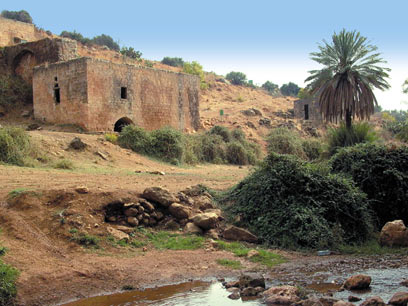
Ein Hokuk and the story of Habakkuk
Between Golani Junction and Kedarim Junction, one moment before you glide into Nahal Tzalmon, are two graves that once belonged to great sheikhs but converted to Judaism and became the graves of righteous Jews
In the Middle Ages, when a number of courageous Jews from abroad risked their lives to immigrate to the Land of Israel on foot, to mourn the destruction of our people, and to prostrate themselves on the graves of righteous Jews, the name “Yakuk” sounded to them like “Hokuk,” and the ancient grave of the great sheikh was identified as the grave of the prophet Habakkuk, the eighth of the 12 biblical prophets.
The prophet, who lived and worked in Judea and definitely not in the Galilee, was mostly involved in a philosophical discussion on how it could be that in a world ruled by the Holy One Blessed be He, evil, malice, and cruelty overpower everything.
This eternal question undoubtedly contained more than a bit of doubt about God’s wisdom. Alternatively, there is deceit and a complete lack of understanding of the concept of divine justice, which is always in need of help from poor believers in order to overcome evil. What power does the omnipotent really have if He isn’t omnipotent?

Tzalmon river (Photo: Anette Besov)
So the name Habakkuk, which means a fragrant mint plant, is the basis of the foolish identification of the grave of Sheikh Yakuk with the figure from an unknown time period and of unknown origin who “wrote” an entire book of prophecy in three parts. The somewhat embarrassing fact that he has no connection to this place other than two “k’s” and a “u” has never led to questioning by those who took advantage of the flight of the villagers of Yakuk to convert the dead man to Judaism and attribute miracles to him.
That’s not all. Nearby is another old mildewing grave that throughout the generations was considered to be the grave of Sheikh Hassan. Then something happened that was unusual even for Israel, where there is nothing miraculous that does not happen: “Rabbi Bahya and his disciples” were chosen to reside under the mildewing tombstone of Hassan, and nothing will stand in the way of those who nurture the Jewish cult of the dead.
There have been two men called “Bahya” in Jewish history. One was from Saragossa in Spain and died in around the year 1340, at a time when Saragossa was a magnificent Arab city. The other was Bahya Ibn Pakuda, who also lived and died in Muslim Spain in around 1050. And who were their disciples? Those who would make the tombs into Jewish tombs have answers.
Since the two Bahyas and all of their disciples together are not equal to a prophet, even a small one like Habakkuk, his tombstone never had a dome.
Until the arrival of the Committee to Save Ancient Graves, which since 1981 has lusted after every old stone in the Galilee and has used donations from God-fearing Jews to place over Rabbi Bahya, who used to be Sheikh Hassan, a dome to protect him from the unfamiliar Galilee climate. And how did they get here from Spain even before the resurrection of the dead in the time of the messiah? It isn’t clear.
Getting there
Drive on road number 70 between the Golani Junction and the Kedarim Junction. Very near to the spot where the road crosses the channel of the national water carrier, on the 88th kilometer, some 2 kilometers south of Kedarim Junction, is a brown sign pointing to a short road of several dozen meters. It ends in a large parking area right above the grave and the large trees.
Going down to Ein Nun
Cross the road, go through the fence (a bit difficult, but not impossible) and go down to the magnificent Ein Hokuk, which flows from an ancient springhouse.
Visit the nearby orchard of giant plum trees, and descend to the very pleasant trail that mostly involves walking in lower Nahal Tzalmon, through the enormous sycamore of Abu Shusha until the beautiful pool of the spring of Ein Nun, on the outskirts of the colony of Migdal in the Ginossar Valley, on the shores of the Sea of Galilee.
Use the hiking and marked trail map of the lower Galilee and the valleys (number 3).
They reign supreme
Idra is the place where Rabbi Shimon Bar Yochai and his disciples lived, and where they worked to discover the secrets of the universe and the hidden Torah. It is the place where he revealed to them his secrets, and so holy and awe-inspiring is it that three of the ten died from the intensity of the event.
Members of the Committee to Save Ancient Graves, who are very hard-working when it comes to taking money from innocent Jews on the pretext that a palace must be built above rocks and stones, and that signs with the names of ancient Jewish scholars must be placed next to them, did in fact find the exact spot where such an important assembly took place, and built a small concrete dome over it, even placing a marble tablet there noting that a generous American benefactor gave the money for the marker.
The tablet also notes that the benefactor’s seven children donated money. A total of nine good Jews from Boro Park gave money for this simple, primitive concrete dome. And once again I think, it took nine wealthy people to donate this lousy, cheap concrete dome? What did they really do with all the money, and where did it really go? Can we perhaps see the receipts?










